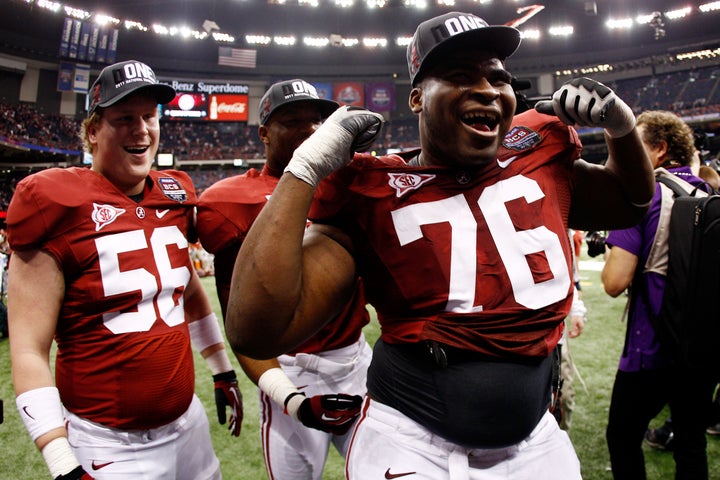
Though it may come as a surprise to my high-school geometry teacher (I was the exception to the Lake Wobegon truism "...and all the children are above average."), the litany of college-sport scandals -- followed by repeated reform proposals -- has me thinking about geometry... specifically Euclidean geometry's Theorem 25 (Angle Sum Theorem): "The sum of the interior angles of any triangle is 180°."
Just as many people confuse a theorem (A statement proven on the basis of other previously established axioms or postulates) with a postulate/axiom (A statement assumed true without proof), many proposed reform agendas assume the existing "Collegiate Model" is, by necessity, the only possible model. Such reformers assume the sum of the interior angles of a "college-sport triangle" must be 180°.
Seemingly without fail, proposed reforms reflect National Collegiate Athletic Association (NCAA) college-sport hegemony based on an a priori acceptance that college sport must exist within the current NCAA paradigm. This theoretical assumption fundamentally limits consideration of possible alterations that would lead to potential solutions to many of the problems currently facing "big-time" college sport.
In the past few decades, the NCAA's term of art "The Collegiate Model" has subtly replaced the long-cherished notion of "amateur" sport. Just as for over two-thousand years, the adjective "Euclidean" was unnecessary since no other type of geometry had been conceived, for most fans and the media, the efficacy of the NCAA's college-sport-as-entertainment model is an unquestioned postulate. Within this world-view the NCAA is not only a ubiquitous administrative body, it is the linguistic creator and caretaker (e.g. student-athlete, amateurism, collegiate model) of college-sport's mythology.
NCAA and university athletic administrators intuitively believe in the axiomatic morality of the current college-sport system. As a result, any developed theorems (bylaws) are deemed true in an absolute, often metaphysical, sense. As a result, NCAA institutional members, as well as media commentators, judges, juries, The Knight Commission, and even Congress are loath to consider any college-sport geometry that might result in "... the end of college sport as we know it."
In contrast to college sport, which clings to its developed geometry, during the early 19th century, several self-consistent non-Euclidean geometries were developed. In addition, since early in the 20th century physicists have understood one implication of Einstein's theory of general relativity is that "Euclidean space" offers a good approximation to the properties of physical space only where the gravitational field is not too strong.
However, as even moderate reform proposals, such as multi-year grant-in-aids or minimal cost-of-living stipends, have shown, college presidents, faculty athletic representatives, university athletic administrators, coaches and many college athletes consistently resist any change to their college-sport geometry. While allowing that "reform" may be called for, they resist substantive change and contend the current collegiate model is unquestionably a fundamentally moral system.
Such reactions demonstrate those in positions of authority within college sport are ill equipped to discover real solutions to big-time college sport's problems. Trapped within their Euclidean college-sport geometry, they are culturally, systemically and philosophically unable or unwilling to break free of big-time college-sport's hegemony.
Defenders of college-sport's status quo admit the existence of strong free-market "gravitational" forces (e.g. television, corporate sponsorship, BCS, coaches' salaries, rampant professionalism in certain sports, etc.), but claim such forces are beyond their control and actually provide for the greater good of "... 400,000 student-athletes who will go pro in something other than sports."
Almost daily, in a variety of media platforms, reform proposals derived from the NCAA's collegiate-model postulate are offered. Unfortunately, such reforms are most likely doomed, since this fictitious collegiate model bears little resemblance to today's big-time NCAA Division-I college football and men's basketball, athletics-as-entertainment juggernaut.
The NCAA's collegiate model -- if it ever really existed -- died long ago and cannot be resuscitated. No matter how many times the big-time college-sport triangle is measured and re-measured, the sum of its interior angles is clearly not 180°. Faced with this reality, what is needed is not a more precise protractor, but the courage to propose AND enact "non-Euclidean" solutions, even if this results in the end of college sport as we know it.
For a variety of reasons, reflected in college sport's trappings (e.g. luxury suites, jumbotrons, and multi-million dollar sponsorship agreements), such courage cannot be expected from university presidents and trustees. It is also unlikely the necessary intellectual audacity will be found in Congress or state legislatures.
However, just as Brown v. Topeka Board of Education overturned Plessy v. Ferguson and ended segregation in public education, a current class-action lawsuit (O'Bannon v. NCAA) may be the catalyst for substantive change. If a non-Euclidean judge or jury concludes the NCAA's collegiate model violates the Sherman Act, the result might spur creation of a hybrid model, incorporating aspects of the International Olympic system, in which professional and amateur athletes co-exist.